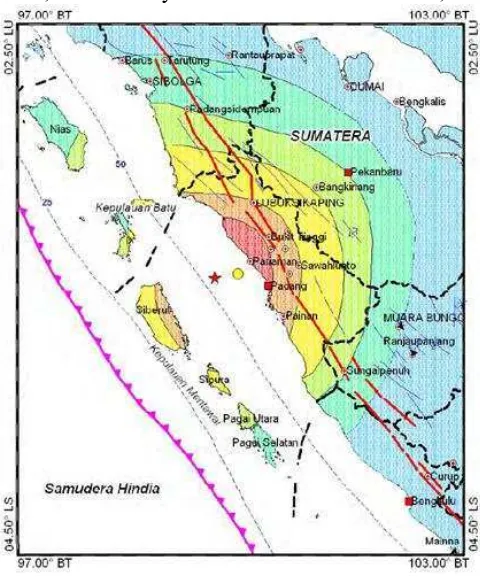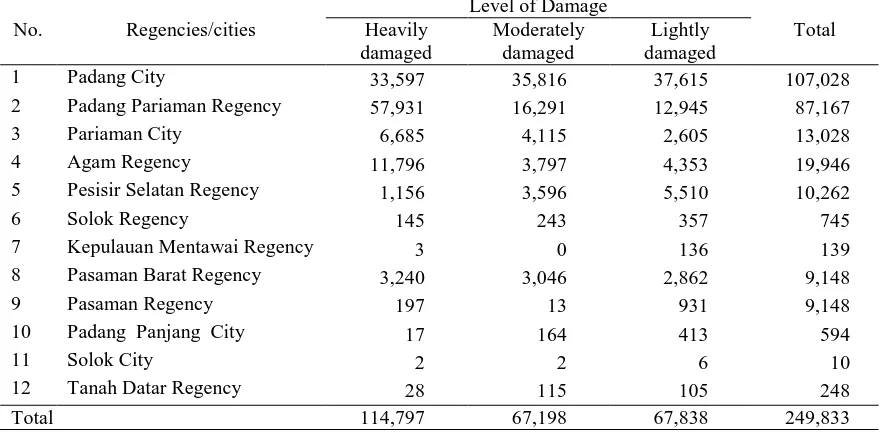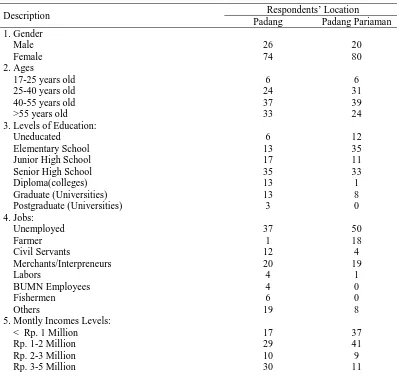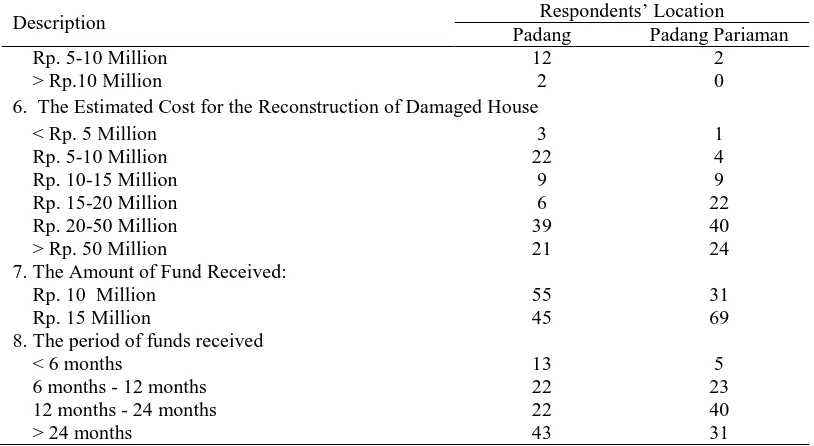Communities' Satisfaction toward Housing Rehabilitation and
Reconstruction Program after 30 September 2009 Earthquake
in West Sumatra Province
Bambang Istijono,Taufika Ophiyandri, Diah Chairisna, and Ade Tadzkia
Centre for Disaster Studies, Andalas University, Kampus Unand Limau Manis, Padang, 25163 Email: [email protected]
ABSTRACT
The government of Indonesia had provided the Rehabilitation and Reconstruction (RR) assistance to 194,636 houses for communities after 30 September 2009 earthquake in West Sumatra province. The community-based development model was adopted in this housing program aid. This study aims to explore into what extent people's satisfaction with the RR program and to identify the difference of satisfaction level between urban area and rural area. The research was carried out by conducting a questionnaire survey to 200 communities. The beneficiaries were invited to determine their satisfaction level based on 5 Likert scale from 1 as ‘not satisfied at all’ to 5 as ‘absolutely satisfied’. The satisfaction level was assessed by two factors, process of reconstruction and result of reconstruction. It was found that the level of communities’ satisfaction is at average level. The satisfaction level of urban communities is 2.75; while the rural communities is slightly higher at 2.88. The satisfaction level of urban and rural communities with the reconstruction process are at 2.63 and 2.75 respectively; while the satisfaction level with the results of the program is at 2.84 and at 2.95 respectively. Communities’ satisfaction with the result of reconstruction is higher than that with the process of reconstruction.
Keywords: post-disaster reconstruction, housing reconstruction, community-based, satisfaction level.
INTRODUCTION
The earthquake of 7.6 on the Richter scale that occurred on September 30, 2009, at 17:16 pm had devastated West Sumatra. It was reported that there were 1195 casualties, and the losses and damages was approximately Rp. 15.41 trillion. The earthquake has created instability in economy and destroyed office buildings, educational and medical facilities, worship buildings, markets, bridges, roads and public houses. The total damage to the community houses included 249,833 housing units. They were assessed as follows: 114.797 units were severely damaged, 67,198 units were moderately damaged and 67,838 units were slightly damaged [1].
Concerning with the damaged houses in West Sumatera Province, the government took the policy of implementing a model of community-based approach. In Indonesia, this model had previously been applied in Aceh after the earthquake and tsunami in 2004, and in Yogyakarta and Central Java after the earthquake in 2006. In this context, the community or society plays an important role in the implementation of the RR to their houses.
temporarily staying at their relatives’ houses, it would be very difficult for them to get back to their normal life.
The RR in housing sector can be categorized as a construction project, in which the success is determined by the accomplishment of project objectives. The accomplishment can be identified by several points, they are; a) the project ends on time b) the planned budget is achieved, and c) the quality of the building construction is based on the standard. Considering that the RR housing program gives a direct impact on the victims who got the beneficence, then the satisfaction factors of the beneficiaries need to be added as a parameter of the success of an RR program. Based on this phenomenon, this study aims to analyze the extent to which the success rate in terms of people's satisfaction toward RR housing program after the earthquake of 30 September 2009 in West Sumatra.
In addition, research conducted by UNSYIAH and UN Habitat [2] RR Aceh post-earthquake indicates that there are differences in the level of satisfaction of urban communities compared to rural communities. This study also suggests to find out the extent to which differences in the level of satisfaction of urban communities compared to rural communities in West Sumatra after the earthquake.
LITERATURE REVIEW
Index Disaster Risk West Sumatera
West Sumatra is one of the provinces that is very vulnerable to disasters. According to BNPB [3] in the list of Disaster Risk Index Indonesia (IRBI), the vulnerability of West Sumatra province was ranked the sixth of all provinces in Indonesia belonging to high classification. Furthermore 19 regencies / cities in West Sumatra also take the high risk of being vulnerable to disaster as shown in Table 1 below. The types of disaster that often occur in West Sumatra are floods, earthquakes, tsunamis, fire settlements, drought, extreme weather, landslides, volcanoes, and sea abrasion. Among those disasters that could likely to occur in West Sumatra, an earthquake is considered as the most deadly disaster which caused a lot of loss and damage. In the last 10 years, a deadly earthquake occurred in 2007 and 2009.
Tabel 1. IRBI of West Sumatera Province
The impact of 30 September 2009 Earthquake
The earthquake that occurred in West Sumatra on September 30, 2009, is a type of subduction earthquake in the Indian Ocean tectonic plate beneath the Pacific Plate Asia. The epicenter as shown in Figure 1 is located at the coordinates of 0.84 degrees southern latitude and 99.65 east longitudes, 57 km away from the coast of Pariaman, in the depth of 71 km.
Figure 1. 30 September 2009 earthquake epicenter (source: [4])
This earthquake caused damage in 12 Cities / Regencies in West Sumatra. The areas that had been heavily damaged included Padang, Pariaman, Padang Pariaman and Agam. In details, the impacts of the earthquake are shown in Table 2 and Table 3. Table 2 shows the negative impact of the earthquake of September 30, 2009, while Table 3 shows the impact of particular damage in the housing sector based on the affected areas.
Table 2.The number of victims and damages after 30 September 2009 earthquake
The Number of Victims and Damages Total Loss of Lives 1,195 People Severely injured 619 People Moderately injured 1.179 People
Missing 2 People
Severely damaged houses 114,797 Unit Tolerably damaged houses 67,198 Unit Moderately damaged houses 67,838 Unit Damaged offices 442 Unit Damaged education facilities 4,748 Unit Damaged health center buildings 153 Unit Damaged worship buildings 2,851 Unit Damaged marketplace facilities 58 Unit
Damaged bridges 68 Unit
Table 3. The number of damaged houses after 30 September 2009 earthquake in West Sumatera 2 Padang Pariaman Regency 57,931 16,291 12,945 87,167 3 Pariaman City 6,685 4,115 2,605 13,028
Jha [5] stated that the reconstruction of community-based/community can be either financial or material aid that is channeled through community organizations actively getting involved in decision making and management development. Referring to the model of community involvement proposed by Davidson et al. [6] and Ophiyandri et al. [7], the post-disaster housing reconstruction program is qualified to be considered as community-based program that is where the community involvement is at a level in the form of collaboration or empowerment (Figure 2)
Figure 2. Minimum Level of Communities Participation toward Community Based Method (source: after [6])
This community -based RR method has been applied to some of the affected countries, such as India, Sri Lanka, Turkey, and Indonesia. Many advantages are obtained by the implementation of community-based RR ([8], [9] and [10]), such as giving a strong sense of attachment toward RR program from the victims, rebuilding social networks in communities, high accountability, reducing corruption, and making it possible to implement the program in accordance with the culture and local customs. However, the community-based model of RR also has a limitation, since a pre - reconstruction takes quite a long time compared to the
contractors based methods which are and a lack of understanding of how the Community -based RR program should be implemented.
Implementation of RR Housing in West Sumatra
Concerning with the RR in West Sumatra, the government established a special agency called the Technical Assistance Team (TPT) which aims to strengthen local government in collecting data, planning, financing, facilitating and coordinating, supervising, monitoring, and evaluating of the RR. TPT works to create strategies and operational policies of the RR. The implementation of the RR itself involves elements of the regional administration, from the province level to the lowest ones in the District / Sub-District / Nagari. Society in the area of RR implementation established community groups (POKMAS – Kelompok Masyarakat) consisting of 20-25 households. The pokmas will be assisted by facilitators who work to assist community groups in both the administration and the technique of house construction.
In general, the RR housing was implemented at four phases, starting from 2009 to 2012 using financial source from the state budget. Due to the limited funds available, the housing assistance funds were the only stimulus. People whose houses were severely damaged received the funds Rp . 15 million, and those whose houses were moderately damaged received Rp. 10 million. The grants were distributed (transferred) directly to the bank account of community groups. Furthermore, the Pokmas distributed the funds to its members. Disbursement of funds was done at two phases, at phase 1, 50 % of the funds are set and at phase 2 another 50% of funds are disbursed after the reconstruction reaches at least 30 % of funding phase I.
RESEARCH METHODOLOGY
This research was conducted using a survey method since it was considered to be the most appropriate method to answer the research questions being asked and to achieve the aim that had been targeted. Referring to Yin [11], the survey method was best used when a study has even led to the question 'what', 'how many', and 'how much'. This research referred to the questions as described by Yin. As it was not possible for researchers to conduct a survey on the entire population, a probability sampling method was applied. Type of sampling used was a multi-stage random sampling, with a probability area and cluster random sampling as consideration. Selection of a multilevel sampling was done as follows; firstly, by selecting a survey region, they are area of the city and the rural areas (District); secondly, the selection was made on the two areas most affected by the disaster, they are the city of Padang and Padang Pariaman district involving 100 samples in each area. In Padang area, the research was conducted in north Padang Sub-District and Koto Tangah Sub-District, while in Padang Pariaman the research was conducted in Sungai Sariak Region.
results of the pilot questionnaire, there was no major revision to it, but only minor changing on repharesing the questions and statements, and no new parameter is added as well. In addition, it was found that respondents seemed to be careless and ignorant if the questionnaires were directly distributed to the respondents. As a result, the method of the survey was altered by implementing a structure interview that was by reading questions in the questionnaire directly to the respondents. Meanwhile, the researchers filled in the answers to the questionnaire. Questionnaires distribution was conducted from September 2014 to October 2014. The survey was generally carried out on Saturday or Sunday because the respondents were off work and they were expected to be in their house. The data which had been collected were then input in the computer into Microsoft Excel program for further statistical analysis.
RESULTS AND DISCUSSION
Respondent Demographics
Table 4 shows the demographics of the respondents in both research location. It appears that most of the respondents are female (77 %) and the predominant age is between 40-55 years old. The majority of education level of respondents in Padang is a high school (35 %), while in Padang Pariaman is an elementary school (35 %). The most dominant type of job status is unemployed (including housewives).
Table 4. Demographics of Respondents Based on the Location of Respondents
Description Respondents’ Location Padang Padang Pariaman
Rp. 5-10 Million 12 2
> Rp.10 Million 2 0
6. The Estimated Cost for the Reconstruction of Damaged House
< Rp. 5 Million 3 1
Majority of respondents in Padang and Padang Pariaman said that the cost of rebuilding of their houses is around 20-50 million. Furthermore, 66% of respondents in the city of Padang and 86% of the respondents in the district of Padang Pariaman claimed that the cost of the damage to their houses was more than Rp. 15 million. Meanwhile the number of respondents in Padang who received housing reconstruction funds Rp. 10 million for their moderately damaged houses are 55 people and who received the funds Rp. 15 million for their severely damaged houses are 45 people. In Padang Pariaman Regency, the number of respondents who received housing reconstruction funds Rp. 15 million for their moderately damaged houses are 31 people and who received the funds Rp. 15 million for their severely damaged houses are 69 people. In general, 43% of respondents in the city of Padang acquired the funds after more than two years, while in the Padang Pariaman regency (40%) acquired the funds within 12 to 24 months after the earthquake.
Satisfaction Level
Table 5 shows the average satisfaction level of respondents to the post- 30 September, 2009, earthquake reconstruction program in West Sumatra.
Satisfaction levels in Padang
Table 5. Average Satisfaction Level from Society towards the Reconstruction Program
Satisfaction Indicators Average The average level of satisfaction in each area
A. PROCESS OF RECONSTRUCTION
• Information and socialisation of the
reconstruction program 2.73
• Starting time of the reconstruction program 2.60
• Identification process of the damaged houses 2.80
• Identification process of beneficiaries 2.67
• The involvement and participation during the
reconstruction process 2.84
• Cooperation among society members 2.71
• Fulfillment of society needs 2.71
• The amount of funds provided 2.45
• The helpful administration and disbursement
process 2.81
• The role of the government in the
reconstruction process 2.71
• The role of the facilitating team (TPM-Tim
Pendamping Masyarakat) to community 2.74
• The role of the facilitators in the process of
reconstruction 2.67
• Availability of labors (carpenters) 2.56
• The experience and expertise of the labors
(carpenters) 2.66
B. RESULTS OF RECONSTRUCTION
• The houses become more resistant to
earthquakes 2.97
• The houses become more comfortable 2.99
• The quality of the houses is better houses 2.98
• The houses have been as the beneficiaries want
to be 2.84
• The fulfillment of the government’s promise 2.74
C. GENERAL SATISFACTION 2.82 Padang = 2.75; Padang Pariaman = 2.88
The indicator level of satisfaction with the reconstruction was slightly better than that of satisfaction with the reconstruction process. Meanwhile, the average level of satisfaction with the reconstruction quality is 2.84. The highest satisfaction level can be identified by realizing people’s comfort after having their newly renovated houses and including the feeling of confidence that their houses are more resistant to earthquakes. While the lowest level of satisfaction as the indicator of people’s trust towards the government's promises was at 2.65. In general, people’s satisfaction with the RR program in Padang city was 2.75.
1 2 3 4 5
PADANG
Satisfaction levels in Padang Pariaman
In general, the average level of people's satisfaction with the community-based reconstruction program in Padang Pariaman was to 2.88. It shared almost the same number as it was in Padang, that was 2.75. So, it was lower than the level of satisfaction on the results of RR housing program, that was 2.95.
The lowest satisfaction level is the indicator of the satisfaction with the amount of the government’s funds given to the disaster victims (2.54). Meanwhile, the highest satisfaction level is the indicator of the people’s satisfaction with the damage assessment to their houses (2.89).
Three of the five indicators of satisfaction with the result of the reconstruction were slightly better than average. These indicators were related to the perception of the beneficiaries who felt more comfortable in their houses (3.07), the houses’ design looked better (3.06 ), and felt more confident than before about toward their houses against the earthquake (3.03). So, it indicates that the community members had internalized the principle of “building back better”.
Cross-Case Analysis
The result of analysis of the satisfaction level of people in Padang city and Padang Pariaman district shows that people in Padang Pariaman district (villages) are more satisfied with the program than those of Padang. As seen in Table 5, from a total of 19 indicators of satisfaction, only one indicator of urban society is in the higher level than that of the rural communities, that is an indicator of the availability of information and dissemination of the RR housing program. This phenomenon shows that people who live in cities have an access to information easier than the villagers. Furthermore, it should be the government's attention to equitable access of information to all levels of society. These results are inline with the results of the research carried out by UNSYIAH and UN-HABITAT [2] related to the post-tsunami in Aceh. In general, people’s satisfaction level in Padang Pariaman is higher than those of Padang. In addition, the satisfaction level with the reconstruction process and the results of the reconstruction are higher too.
In general, based on the analysis of 200 respondents, it is noted that the people's satisfaction level was 2.82. Assessment of the satisfaction level with the process of reconstruction was 2.69, while the assessment of result of the reconstruction was 2.90. This phenomenon could be a recommendation for the government not to focus only on the outcome of a program, but the process of reconstruction needs more attention and has to be handled carefully. In the RR housing community-based program, the reconstruction process also plays an important role. The reason is that there are many benefits that can be obtained by conducting the community-based program, such as creating the unity among the community.
The differences in satisfaction levels between rural and urban communities may be related to the level of education, occupation and the income of respondents. For example, in the case of income / salary, in Padang Pariaman, 78 % of respondents had an income less than Rp 2 million, while in the city of Padang only 46 % respondents had an income less than Rp 2 million. Logically, the lower income people would be more satisfied than people who earn higher if the amount of funds given is the same. Based on the correlation of the two phenomena, it is suggested to the future researchers to conduct the inferential statistical analysis.
CONCLUSION
The result of the research shows that the satisfaction level of communities in West Sumatra with the RR housing program is average, that is 2.82. If it is compared the indicators of the reconstruction process and the results of the reconstruction, the satisfaction level with the results of the reconstruction is higher than that of the reconstruction process. The value of the reconstruction process is 2.69, and the value of the results of reconstruction is 2.90. In addition, based on the results obtained from the beneficiaries’ satisfaction level in Padang city and Padang Pariaman, it can be concluded that the satisfaction level of rural communities is higher than the satisfaction level of the urban communities. The satisfaction level of rural communities with the RR housing program is 2.88, while the urban community is 2.75. In more detail, the satisfaction level of urban and rural communities with the process of the RR housing program are 2.63 and 2.75; while the satisfaction levels with the result of the RR housing program are 2.84 and 2.95.
The lowest level of community satisfaction is on amount of funding provided by government to carry out reconstruction. This urges government to change the method for financial assistance to a more innovative way, such as by providing an earthquake insurance or creating a special account for each family to overcome disaster impact. Moreover, since the satisfaction value of ‘the process of reconstruction’ is lower than ‘the result of recosntruction’, government has to pay much attention on activities carried out in the former than the later. Especially in the community-based reconstruction project, many of crucial activities are taken place in pre-construction stage.
REFERENCES
[1] Pranoto, S., Sentosa, S., Kayo, R.B.K.P., Karimi, S., Fauzan, Ermiza, Z. and Antoni, S. (2011). Lesson Learned, Pembelajaran Rehab Rekon Pasca Gempa di Sumatera
Barat 30 September 2009, BuildingBack Better. Padang: TPT RR.
[2] Universitas Syiah Kuala and UN-HABITAT (2006). Post Tsunami Settlement
Recovery Monitoring in Aceh. Banda Aceh: UNSYIAH-UN-HABITAT
[3] BNPB (2011) Index Rawan Bencana Indonesia
[4] Volcanological Survey of Indonesia (2009), http://vsi.esdm.go.id
[5] Jha, A. K., Barenstein, J. D., Phelps, P. M., Pittet, D. and Sena, S. (2010), Safer Homes,
Stronger Communities: A Handbook for Reconstructing after Natural Disasters,
Washington: The World Bank
[6] Davidson, C.H., Johnson, C., Lizarralde, G., Dikmen, N., Sliwinski, A. (2007). Truths and Myths about Community Participation in Post-disaster Housing Projects. Habitat
International, 31(1), 100–115.
[7] Ophiyandri, T., Amaratunga, D. and Pathirage, C. (2010). Community Based Post
Amaratunga, D., Haigh, R., Keraminiyage, K., and Pathirage, C. (Eds). CIB World Congress, Salford Quays, UK, 10-13 May 2010.
[8] Arslan, H. and Unlu, A. (2006), The Evaluation of Community Participation in Housing Reconstruction Projects after Duzce Earthquake. In Proceedings of
International Conference and Student Competition on Post-disaster Reconstruction,
"Meeting stakeholder interests", Florence, Italy, May 17-19, 2006, Available at: http://www.grif.umontreal.ca/pages/ARSLAN_%20Hakan.pdf#
[9] Barenstein, J.D. (2008), From Gujarat to Tamil Nadu: owner-driven vs
contractor-driven housing reconstruction in India, Available at: http://sheltercentre.org/sites/
default/files/IREC_OwnerDrivenVsContractorDrivenHousingReconstruction.pdf [10] Lawther, P. M. (2009), Community involvement in post disaster re-construction - Case
study of the British Red Cross Maldives recovery program, International Journal of
Strategic Property Management, Vol. 13 No. 2, pp. 153-169.
[11] Yin, R.K. (2009). Case study research: Design and methods (4th ed.). London: Sage Publications.
[12] Ophiyandri, T., Amaratunga, D., Pathirage, C., & Keraminiyage, K. (2013). Critical success factors for community-based post-disaster housing reconstruction projects in the pre-construction stage in Indonesia. International Journal of Disaster Resilience
in the Built Environment, 4(2), 236-249.



